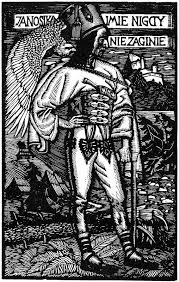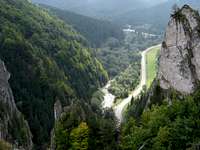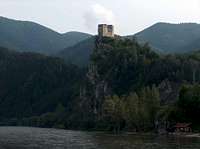Jánošík, Carpathian Robin Hood
![Janosik figure]() Figure of Juraj Jánošík
Figure of Juraj Jánošík![Terchová]() Statue of Juraj Jánošík in Terchová
Statue of Juraj Jánošík in Terchová
Janosik is a kind of mountain hero for many Poles, Slovaks and Czechs, who know him through various stories and legends in their childhood, and a bunch of film adaptations, the latest in 2009.
But unlike Robin Hood, to which is often compared, Janosik really existed. His true story, if not as romantic, provides us however a fascinating history and geography lesson.
The facts plunge us back into a very turbulent period of history for which, in order to fully understand the context, a small retrospective is necessary.
A bit of history

Map of Hungary in the 18th century
We are in the early eighteenth century in a buffer zone between Southern Poland (a zone corresponding to the later called Duchy of
Galicia), still under the Polish crown, but object of many covetings (it goes to the Habsburgs in 1772), and Hungary. Slovakia, true home of Janosik, only represents small region of the latter with its "dialect". Hungary itself is a part of the great Austrian Habsburg Empire. Colonization badly endured by the latter, and twice more by the other.
The
Carpathians, at that time, are a wild area, a key crossing-point between two powerful empires, very dangerous region, teeming with highwaymen of all sorts. Other famous outlaws, more or less known, also contributed to this reputation of "European Wild West", like
Ondraszek (1680-1715, Polish), often confused with Jánošík, or
Portasz Martyn,
Wojciech and Mateusz Klimczakowie,
Wasyl Bajurak,
Iwan Bojczuk or
Oleksa Dowbusz, who terrorized regions further east, till the Hutsul countries (
Carpathians of Ruthenia). These brigrands never operated alone, but within a very hierarchical group, "Wataha", some of them collecting dozens of guerrilleros (the "Zbójnicki" (PL) / "Zbojníci" (CS)), and on whose head reigns the "watażka".

Old representation of Jánošík
It is within this context that begins the story of Jánošík, superposed with the one of
Count Francis II Rákóczi, Hungarian national hero, author of the failed uprising against the Habsburgs in 1703. Juraj Jánošík, whose real name, is a young captured soldier, who was enroled by force into the Austrian army, where random made him a prison guard. He didn't need so much to fly away, helping on the way Tomas Uhorcik, dangerous robber to escape as well, with whom he eventually founded his band of mercenaries (which we call "Harnaś", name taken by a famous Polish beer brand, whose logo stamps a stylized Jánošík). Many other Slovak oulaws joined the "dream team" afterwhile, as well as some Poles like Gavora, Satori and Oresiak.
They spread terror for years, robbing a large number of dignitaries, mostly Hungarians and Austrians, sometimes escorted, and the most often by ambush in the most rugged and impenetrable corners of the Carpathians. It is often said that Jánošík always left his victims alive, although this detail does make unanimity (by "victim" we mean personalities, no matter about soldiers and so on !). It is also said a hidden cave served as headquarters. Many fictions put these scenes in the
Tatras, but the band of Jánošík "haunted" more precisely the
Malá Fatra and neighboring
Choc Mountains.
Jánošík did not hesitate to get rid of disturbing "employees" or rivals within his own clan, whose success led occasional machinations of all kinds. Detail which is not the least: although the rich local gentry made its main target, he did not redistribute money to the poor. Worse, contemporary accounts describe him as a very cruel and violent character.
The adventure ends in 1713 when, following a betrayal, he is arrested in a hostel of
Valašská Dubová, and eventually tried, imprisoned and hanged on a hook in
Liptovský Mikuláš castle. The legend says he taunted his judges and executioners until the last moment and, to remove their insane pleasure to witness his agony, he threw himself on the hook, uttering a final insult.
The fictional Jánošík
![The making of the film Janosik in Štefanová, in this frame of one of the houses]() Making of 1963 "Jánošík " in Štefanová, SK
Making of 1963 "Jánošík " in Štefanová, SK![Juraj Jánošík]() Jánošík in an early 1935 Czechoslovak movie
Jánošík in an early 1935 Czechoslovak movie
Skoczylas's representation of the Polish outlaws
The history of the man ends, but that of the fictional character is just beginning. By the end of World War I, the Austro-Hungarian Empire is dismembered, giving birth to a bunch of new states, including Czechoslovakia.
Galicia becomes part of Poland again in 1921, which just proclaimed its independence. This "revenge" of the "Slavic states" is a favourable context for the cult of his personality, whose "resistant and independantist" sides will be glorified as time passes and memory fades.
It is interesting to note that subsequently, a book about Jánošík ("Jur Jánošiak") was also released in Serbia, another former country victoriously emerged from the conflict.
In Czechoslovakia, Jánošík is a true national icon, especially for Slovaks, and occasionally used to stand out from the Czechs, to who they are linked by a marriage of circumstances, and who praise other characters like
Soldier Švejk.
World War II comes along, and then Poland and Czechoslovakia enter their respective socialist hibernations. Once again, the Slavs, supported by the Russian big brother, have pushed out the perfidious german-speaking colonizers. In addition, Jánošík, the thief who gives generously to the poor, corresponds well to the ideals of that time.
It is interesting to note how the cults of Jánošík developped their way separately in each country. One of the most noticeable examples, visual, is the hat. While Polish Janosik wears a high cylindric hat, Slovak Jánošík wears the Slovak highlander's hat, more similar to the traditional shape. Additionally, Polish Janosik tends to be armed with traditional weapons such as the mountaineers axis ("ciupaga"), while Slovak Jánošík is seen more often with an old gun in hand, in the style of old western heros.
Paradoxally, it seems that the Slovak version is closer to the reality. Back to the hat, the so-called authentical (it makes the object of a debate between Slovak and Hungarians, polish readers can read
this) is exposed in the museum of Ruzomberok. The polish hat-shape tends to be inspired from the
Hussar military costome, which occured later in history. Such representations tend also to date from the era of artists such as
Witkiewicz and
Skoczylas.
It is also the maturing of the film industry, and at least a half-dozen of films are being made in several countries, with a flagship Czechoslovakian film in 1962 (Paľo Bielik) and a glorious Polish Janosik in 1974 (Jerzy Passendorfer), popular enough to have been adapted into television series, and from where come from the image of the contemporary Jánošík many of us know. The personality of the character is endowed on the way with an extra "Arsene Lupin" side: Athletic, elegant and refined, he robs not only purses, but occasionally a few hearts at the scene of his misdeeds. Without being a faithful transcription history, the film still seduces as much younger and older ones, as much for its simplicity than the talent of actors, with hilarious facial expressions. The soundtrack is also a melody that many know by heart.
The attempt of historical transcription came only twenty years after the fall of the Iron Curtain, with a Polish-Hungarian-Slovak
coproduction (directed by Agnieszka Holland), which targets the general public, and where Jánošík is interpreted by a young. .. Czech ! If the scenario is far from having seduced critics, the film has reached at least two big goals: first of all, international, by ending the "national Janosik's", and justify an ambitious title: "Janosik, Prawdziwa Historia" ("The true story"). Moreover, it is heavily loaded with historical reconstructions, with a particular mention to the fidelity of the costumes, and choice of locations: a trained eye will recognize many well known castles, folk museums with authentic houses from that time, and various photogenic places of the Carpathians.
A little touristic conclusion...
![]()
Panorama of Rozsutec and Poludnové Skaly from Štefanová |
![Lietava Castle]() Lietava Castle
Lietava Castle![Strečno]() Strečno castle
Strečno castle
This leads to a tourism conclusion, visiting the den of Jánošík, which lies on the area of nowaday's
Malá Fatra national park. History books often quote the town of Terchová, but it is more precisely to the well named Valley Vrátna Dolina ("Valley of the gates"), in which we must head into, where two spectacular limestone walls ("Tiesňavy"), leave a narrow space only for the road and the river. No longer doubts, it can only only be the lair of Jánošík and his band !
Further up, above the village of Štefanová, in which was filmed the Czechoslovakian Jánošík of 1963, stands the proud figure of dolomitic
Rozsutec (1610m), whose base, a limestone ground, is cut by a labyrinth of gorges that tourists can walk through a network of bridges and ladders:
Horné Diery and Dolné Diery (sometimes named together "Jánošíkovi Diery"). Many of them also mention this place as the most beautiful Slovak mountain outside the
Tatras. That's saying something when we know the wonders of this small country ! A place which will delight all lovers of nature ... and
stories.

Panorama of the Kezmarok Castle |




















Comments
Post a Comment